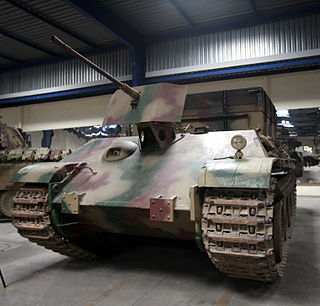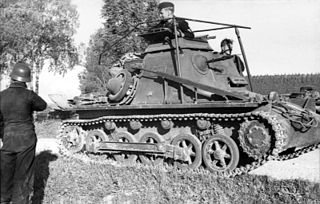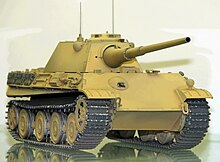
The Panzer II is the common name used for a family of German tanks used in World War II. The official German designation was Panzerkampfwagen II.

The Panzerkampfwagen III, commonly known as the Panzer III, was a medium tank developed in the 1930s by Germany, and was used extensively in World War II. The official German ordnance designation was Sd.Kfz. 141. It was intended to fight other armoured fighting vehicles and serve alongside and support the similar Panzer IV, which was originally designed for infantry support.

This article lists production figures for German armored fighting vehicles during the World War II era. Vehicles include tanks, self-propelled artillery, assault guns and tank destroyers.

The Panzerkampfwagen 38(t), originally known as the ČKD LT vz. 38, was a tank designed during the 1930s, which saw extensive service during World War II. Developed in Czechoslovakia by ČKD, the type was adopted by Nazi Germany following the annexation of Czechoslovakia. With the German Army and other Axis forces, the type saw service in the invasions of Poland, France and the USSR. Production ended in 1942, when its main armament was deemed inadequate. In all, over 1,400 Pz. 38(t)s were manufactured. The chassis of the Pz. 38(t) continued to be produced for the Marder III (1942–1944) with some of its components used in the later Jagdpanzer 38 (1944–1945) tank destroyer and its derivative vehicles.

The 15 cm sIG 33 (Sf) auf Panzerkampfwagen 38(t), also known as Grille was a series of self-propelled artillery vehicles used by Nazi Germany during World War II. The Grille series was based on the Czech Panzer 38(t) tank chassis and used a 15 cm sIG 33 infantry gun.

The Bergepanzerwagen V, often referred to as the "Bergepanther", was an armoured recovery vehicle used by the German Army in WWII. It was a variant of the Panzerkampfwagen V Panther.
The Panzerkampfwagen I was a light tank produced in Germany in the 1930s. The Panzer I was built in several variants and was the basis for a number of variants listed below.

The Heuschrecke 10 was a German prototype self-propelled gun and Waffenträger developed by Krupp-Gruson between 1943 and 1944. The official designation of the vehicle was 105 mm leichte Feldhaubitze 18/1 L/28 auf Waffenträger Geschützwagen IVb and was to be built in Magdeburg, Germany. The Heuschrecke featured a removable turret which could be deployed as a pillbox or towed behind the vehicle as an artillery piece.

The Krupp Protze was a six-wheeled 6x4 German truck and artillery tractor produced between 1934 and 1941 and heavily used in World War II. It was powered by a 4-cylinder, 55 hp or, from 1936, 60 hp Krupp M 304 petrol engine. Its main purpose was to tow artillery, especially the 3.7 cm Pak 36 anti-tank gun, and transport motorized infantry.

The kleiner Panzerbefehlswagen, known also by its ordnance inventory designation Sd.Kfz. 265, was the German Army's first purpose-designed armoured command vehicle; a type of armoured fighting vehicle designed to provide a tank unit commander with mobility and communications on the battlefield. A development of the Army's first mass-produced tank, the Panzer I Ausf. A, the Sd.Kfz. 265 saw considerable action during the early years of the war, serving in Panzer units through 1942 and with other formations until late in the war.

The VK 30.01 (P) was the official designation for a heavy tank prototype proposed in Germany. Only two prototype chassis were built. The tank never entered serial production, but was further developed into the VK 45.01 Tiger (P). Porsche called it the Typ (Type) 100.

The Schmalturm was a tank turret designed for use on the Panther Ausf. F medium tank. There was a Krupp proposal to fit it onto the Panzer IV medium tank as well. It featured a narrow front to maximize protection while minimizing weight. It was both lighter and easier to manufacture than the standard Panther turret. The turret had a stereoscopic rangefinder with lenses on either side of the turret, located in spherical bulges. No Schmalturms entered series production.

The VK 30.01 (H) is a German prototype heavy tank developed by Henschel in Germany during World War II. It was rejected for production likely due to being outdated by the time it was meant to be produced. The chassis from this project went on to form the chassis for the Sturer Emil self-propelled anti-tank gun project.

The Panzerkampfwagen II Ausf. L "Luchs" is a German light tank from the Second World War, developed between 1940 and 1942 by Daimler-Benz and MAN. The Luchs was the only Panzer II design with the Schachtellaufwerk overlapping/interleaved road wheels and "slack track" configuration to enter series production, with 100 being built from September 1943 to January 1944 in addition to the conversion of the four Ausf. M tanks. Originally given the experimental designation VK 13.03, it was adopted under the alternate name Panzerspähwagen II and given the popular name Luchs. The Luchs was larger than the Panzer II Ausf. G in most dimensions. With a six speed transmission, it could reach a speed of 60 km/h (37 mph) with a range of 260 km (160 mi). The FuG 12 and FuG Spr radios were installed, while 330 rounds of 20 mm and 2,250 rounds of 7.92 mm ammunition were carried.


















